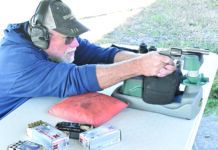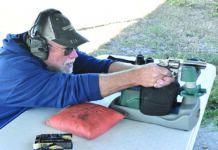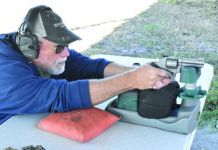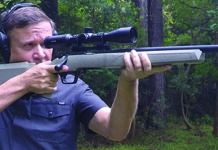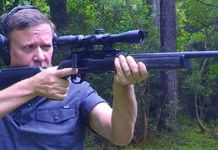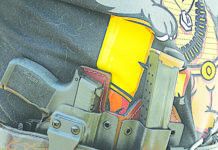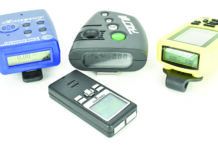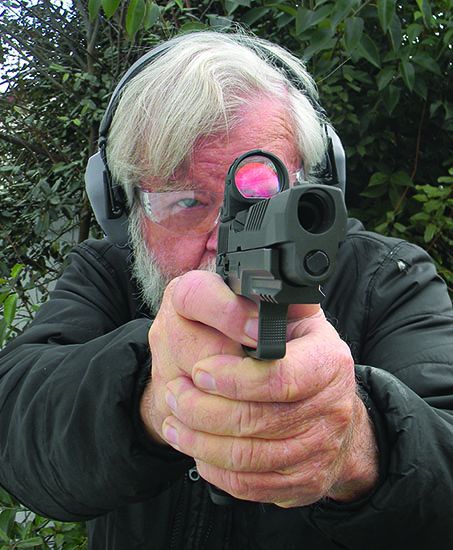We recently had a chance to shoot two metal-frame striker-fired compensated 9mm Luger pistols from SIG Sauer and Smith & Wesson to assess how we liked their aluminum receivers, extended magazines, night sights, and other features. In the end we think one pistol is better for competition and the other better for personal defense, but either would cross over to the other’s territory with nothing to be ashamed of.
The first handgun was SIG Sauer’s P320 AXG Legion, $1400. The AXG version is SIG’s answer to the popular trend of offering a metal-frame version of a polymer-frame striker-fired handgun. The P320 AXG Legion is similar in outline to the P320 and the U.S. military-issue M17 — but differs in important details. The trigger action and sights are the same as most P320 models, while the Legion features a flat trigger, compensator, and aluminum frame.
The Smith & Wesson 2023 SPEC Series M&P9 Metal M2.0 13974, $949, is finished in a tactical OD green that is attractive over the stainless slide and aluminum frame. The slide features both forward and rear cocking serrations. The front serrations are dished in more than it appears in images. This makes for good leverage, although neither pistol was difficult to rack.
We used two types of ammunition during the combat-firing evaluation at the usual 7, 10, and 15 yards, and we also combat fired at 25 yards, which is a typical competition range. The first fodder was Federal American Eagle 147-grain Syntech Training Match. Heavier bullets often provide better accuracy in the 9mm, we’ve found. The second round was a test of accuracy and feed reliability as we fired Federal Train & Protect 115-grain JHPs. During combat firing, we drew the big SIG and Smith pistols from a Galco belt slide or a Galco Yaqui slide, large size. In benchrest firing, we added Black Hills 124-grain JHPs. Here’s what we thought of the pistols individually:
SIG Sauer P320 AXG Legion 9mm Luger
$1400
Gun Tests grade: A
A nicely made pistol with good features and our choice of the two pistols tested for competition. Reliability was not a concern, and the pistol is more accurate than most 9mm pistols we have tested.
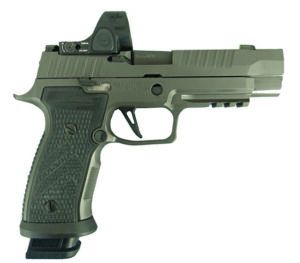
| Action Type | Single-action semi auto |
| Overall Length | 8.2 in. |
| Overall Height | 5.5 in. |
| Maximum Width | 1.6 in. |
| Weight Unloaded | 36.3 oz. |
| Weight Loaded | 42.4 oz. |
| Barrel Length | 3.9 in. |
| Slide | Legion grey phosphate-finished steel |
| Slide Retraction Effort | 17.9 lbs. |
| Receiver | Aluminum |
| Front Strap Height (w/o magazine well) | 2.4 in. |
| Rear Strap Height | 3.75 in. |
| Grip Thickness | 1.25 in. |
| Grip Circumference | 5.75 in. |
| Magazines | (3) 21 round |
| Rear Sight | SIG X-RAY3 night sight |
| Front Sight | SIG X-RAY3 night sight |
| Trigger Pull Weight | 4.9 lbs. |
| Trigger Span | 2.6 in. |
| Sight Radius | 5.9 in. |
| Safety | No manual safety |
| Warranty | Limited lifetime |
| Telephone | (603) 610-3000 |
| Website | SIGSauer.com |
| Made In | U.S. |
The P320 AXG Legion features a dual-port compensator built into the longish slide. The result is a type of long-slide P320, but with a 3.9-inch barrel. The result looks a little odd when the slide is racked and the standard-length barrel is exposed. The pistol doesn’t make use of the longer slide to increase the sight radius because the front sight rides behind the compensator. Thus, the P320 AXG Legion avoids having a compensator hanging on the end of the barrel, which may enhance reliability because there is no weight on the end of the barrel to affect feeding, cycling, and barrel tilt. But the Smith & Wesson was just as reliable with its detachable comp.
The SIG slide features forward and rear cocking serrations. The pistol features SIG X-RAY3 self-luminous night sights. The SIG’s three-dot pattern is comparable to the Smith & Wesson; we detected no real difference save for the Spec’s height. The SIG sights won’t co-witness with the Trijicon red dot we used in the test.
The pistol is ambidextrous in most ways because it features a dual slide lock. The magazine release is easily pressed by a left-hand forefinger. The takedown lever rotates downward and releases the slide. It isn’t ambidextrous, but neither is it difficult to use quickly.
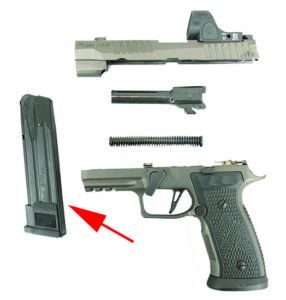
Disassembly is simple enough. Remove the magazine, lock the slide to the rear, and check the chamber. Then rotate the slide releases downward and run the slide forward. Remove the recoil-spring assembly and pull the barrel out of the slide.
The trigger action is smooth and short. Pressing the P320’s trigger takes some practice to prevent jerking the trigger. The raters firing the P320 AXG Legion found the trigger press short and crisp, with a rapid and audible reset. The pistol’s trigger is well suited to competition and range use, we felt. Our example’s trigger compression broke at 4.9 pounds out of the box, then, after cleaning and the test fire, 4.6 pounds. The SIG trigger does not use the archetypical safety lever set in the trigger face. A firing-pin block is the only safety. The striker block moves away from the striker when the trigger is pressed.
The grip frame is manufactured from aluminum, resulting in a heavier platform than the polymer-frame P320. The P320 AXG Legion is finished in Legion Grey. The finish is nicely applied and attractive over the P320’s stainless-steel slide. The frame features an accessory rail for mounting lights or lasers. The grip tang is extended in what is commonly referred to as a beavertail extension. The grip frame is aggressively checkered, with both the front strap and back strap offering good traction. The pistol features removable stocks. The grip stocks are nicely checkered G10. The pistol is larger than some, but offers good handfit and plenty of texture. The pistol features a magazine funnel. The grip flares slightly at the base of the grip. Only a very large hand would rest on this area. The pistol is supplied with Legion accessories, such as a challenge coin and three P320 AXG Legion 21-round magazines. These magazines are metal with generous base pads. They add slightly less length to the grip than Smith & Wesson’s 23-round 9mm magazines.
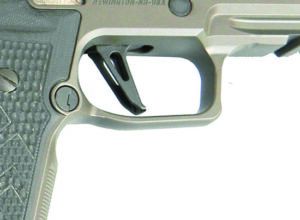
For the sake of modernity, we fired the pistols with red-dot sights mounted. We traded a little back and forth and used Holosun, TruGlo and Trijicon optics, and a Meopta on the S&W at one point. The SIG offers direct mount fitting with both Trijicon and SIG Romeo red dots. You must order a plate for other sights. In that regard, the Smith & Wesson CORE mounting system is far more versatile. We would not opt out of the SIG simply based on the mounting situation, as we will see in some regards the SIG is the better shooter, but for many shooters the CORE system is superior. Most of the firing was done with a Trijicon SRO mounted on the SIG. The SRO has a wider window than most optics.
The pistol is well balanced. It isn’t as fast to an accurate first shot as some handguns. Once up and in hand, however, the P320 AXG Legion is very stable. Fired for accuracy, the pistol literally put one ragged hole in the 7-yard target. Results out to 25 yards were very good. While we don’t perceive the 9mm as a hard kicker in a service-size pistol, the compensated SIG proved mild and comfortable to fire.
To compare the recoil of compensated and uncompensated pistols, one of the raters brought along two of his favorite full-size pistols, a Walther PDP 5-inch-barrel 9mm and a Walther PPQ Match 9mm. Firing the light-kicking PDP and PPQ Match directly after firing the compensated test guns was a revelation. Pistols we thought kicked only a little were startling compared to the compensated 9mms. The metal-frame compensated guns were much more comfortable to fire. Speed between shots (splits) was much faster with the test guns. The pistols definitely would have a place in competition and in home defense as well. The metal frame and compensator make that much difference. For personal defense, carrying the SIG’s weight around is another story.
Our Team Said: Compared to the Smith & Wesson Military & Police M2.0 Spec 9mm, the SIG posted slightly better combat groups, and a minority fired the Smith & Wesson more accurately. Those used to Glock and Smith & Wesson-type triggers sometimes did not acclimate as well to the P320 trigger. Off the bench, the P320 AXG Legion fired a number of brilliant groups. One group was almost under an inch, fired with the Trijicon SRO set at its lowest setting. In the end, there was nothing to rate the SIG down on. The pistol is completely reliable. Accuracy is excellent. Personal preferences about the trigger, the optics mounting system, and the magazines were not deal breakers. The pistol rates a solid A.
| 9MM LUGER RANGE DATA | |||
| Federal Train & Protect 115-grain VHP TP9VHP1 | SIG Sauer P320 AXG Legion | S&W Spec M&P9 Metal M2.0 | |
| Average Velocity | 1102 fps | 1156 fps | |
| Muzzle Energy | 310 ft.-lbs. | 341 ft.-lbs. | |
| Smallest Group | 1.25 in. | 1.9 in. | |
| Average Group | 1.8 in. | 2.5 in. | |
| Federal American Eagle 147-grain FMJ AE9SJ3 | SIG Sauer P320 AXG Legion | S&W Spec M&P9 Metal M2.0 | |
| Average Velocity | 899 fps | 940 fps | |
| Muzzle Energy | 264 ft.-lbs. | 288 ft.-lbs. | |
| Smallest Group | 1.25 in. | 1.8 in. | |
| Average Group | 1.7 in. | 2.5 in. | |
| Black Hills Ammunition 124-grain JHP | SIG Sauer P320 AXG Legion | S&W Spec M&P9 Metal M2.0 | |
| Average Velocity | 1108 fps | 1150 fps | |
| Muzzle Energy | 338 ft.-lbs. | 364 ft.-lbs. | |
| Smallest Group | 1.0 in. | 1.9 in. | |
| Average Group | 1.7 in. | 2.6 in. |
We fired groups at 25 yards from a benchrest position using an MTM Case-Gard K-Zone Shooting Rest. We used a Competition Electronics Pro Chrony to measure muzzle velocities.
Written and photographed by Gun Tests Staff. GT


